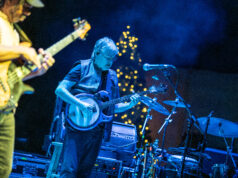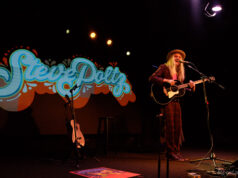
The Wallflowers at Rams Head Live, Aug. 23, 2019. (Photo by Matt Ruppert)
Towheaded and impressionable, I found Bringing Down the Horse at Sam Goody’s end-of-row display shelf in the Towsontown Mall, its stamplike W and stars drawing my eyes. I pulled a pile of ones out of my pocket, the slowly-earned financial detritus of chores completed and change received, counting out the $16.99 required. Then (and maybe now), spending my money filled me with some worry, concern that my decision would ruin my mood. That, somehow, this thing I’d promised my time wouldn’t be worthy of it.
I had a Walkman, silver with a faux-leather cover, but I couldn’t bring it to public places with me. Listening to music required — and sometimes continues to require — an extra kind of vulnerability, as I remove my hearing aids to listen to headphones. I remember getting home, settling into the bottom of my bunkbed, pulling the booklet, popping open the Walkman — such a satisfying click — and the opening hiss of the tape as it played into my ears. And then “One Headlight,” a song I should’ve known but didn’t, a song that led to a quiet fervor and gentle obsession. I inhaled the album, and as I slowly accumulated more chore-earned dollars, I bought their debut on tape, too, inviting the songs to wade into my veins. (They’re still there, carrying oxygen and whatever it takes to keep me alive.)
Stream Bringing Down the Horse by The Wallflowers on Spotify:
And then every album after that, the same, though I could afford them more easily by the beginning of high school (for Breach and Red Letter Days), setting aside income from whatever job I worked that summer and year. College came next, and I remember the desire to be cool, to avoid past loves, and Rebel, Sweetheart passed by in the quiet moments when I listened alone. I came to it later, falling in thrall to its charms as an adult, “The Beautiful Side of Somewhere” ringing bells for me.
When music hits you, you can stand to feel a little pain. It breaks you, flooding the broken parts with molten gold.
 Jakob Dylan taught me that before anybody else. So when The Wallflowers came to Baltimore at Rams Head on Aug. 23, I found myself ready to ride the rails and listen as closely as I ever have.
Jakob Dylan taught me that before anybody else. So when The Wallflowers came to Baltimore at Rams Head on Aug. 23, I found myself ready to ride the rails and listen as closely as I ever have.
Past selves populated the experience, but so too did the present self, the version of me that looks for the small smiles between band members, that begs the audience to give a little back to the music. A nearly yearly tradition, the room filled quickly, the audience dispersing across the floors for the best possible spot to see the stage.
Jakob brought his touring band of the last few years: Stanton Adcock on lead guitar, Steve Mackey on bass, Jimmy Wallace on keys, and Lynn Williams on drums, all with plenty of room to shine, though Jakob certainly starred. Jakob Dylan has a presence, a strength of personality and self-assurance that exudes from him almost infectiously. He beckoned us to follow him, smiling, lifting his guitar into the air, pointing at us, and ultimately delivered the kind of rock and roll show that delivers joy and catharsis in equal parts.
Because The Wallflowers are essentially Jakob Dylan, they played a few choice cuts from Women and Country (his second solo record), including opening the show with the little riot of “Standing Eight Count” and a mid-set interlude of standouts “Everybody’s Hurting” and “Smile When You Call Me That.”

Jakob Dylan of The Wallflowers
Surprisingly (to me, anyway), the band certainly featured Bringing Down the Horse, six cuts making it into the setlist, including the crowd-pleasing hits “6th Avenue Heartache”, “Three Marlenas,” and “One Headlight,” each of which rippled like a heavy wind through the audience. They also unveiled “God Don’t Make Lonely Girls” (a song I credit with getting me into the heartland rock of Springsteen and Petty — more about that in a moment), “The Difference,” and “Invisible City.”
“Invisible City” washed over me like a hug, its verses familiar, evoking the decades spent with Bringing Down the Horses, with verses like “the imitation of good faith / is how you stumble upon hate” and “now I try not to tell lies / but there’s pressure inside / so I’ve learned how to compromise / good people for alibis” still sting with the ring of sharp truths. Jakob never let these heavy, sometimes obtuse songs cloud the joy of the show. He commented about the tall man on the rail, told little jokes, entertained a request during the encore (“Shy of the Moon”).
And during the encore, after Stanton left his guitar to ring feedback on the ground, the band slowly refilling the stage, Jakob walked out in a tight, short-shouldered black tee and a newsy cap, letting loose a sunbright smile, announcing that they couldn’t leave Baltimore without playing this next song. He told the audience he made the band learn the song so they had to play it before ripping into Springsteen’s “Hungry Heart.”
Jakob paused in the middle of the song, the band still playing behind him, slowly working through a roll call of titles, solos, and miniature monologues. “This is a short song…do you know how he stretches it out longer?” he asked, answering his own question, “By making the audience sing!” before holding out his own mic. It’s the kind of rock and roll moment that sticks to the bones and soothes the soul, and The Wallflowers fill their shows with these moments.
 They ended the night with a rousing rendition of Petty’s “The Waiting,” a month and a half before the two year anniversary of his death, a kind of raucous requiem. But the highlights of the night, unequivocally, were the band’s own songs. “Sleepwalker,” “Misfits & Lovers,” and all of the songs already mentioned.
They ended the night with a rousing rendition of Petty’s “The Waiting,” a month and a half before the two year anniversary of his death, a kind of raucous requiem. But the highlights of the night, unequivocally, were the band’s own songs. “Sleepwalker,” “Misfits & Lovers,” and all of the songs already mentioned.
If there’s ever been a better rock and roll show at Rams Head, I don’t know about it. Don’t miss ‘em if they’re coming through. Here are some more photos from the show on Aug. 23, courtesy and copyright of Matt Ruppert.

















